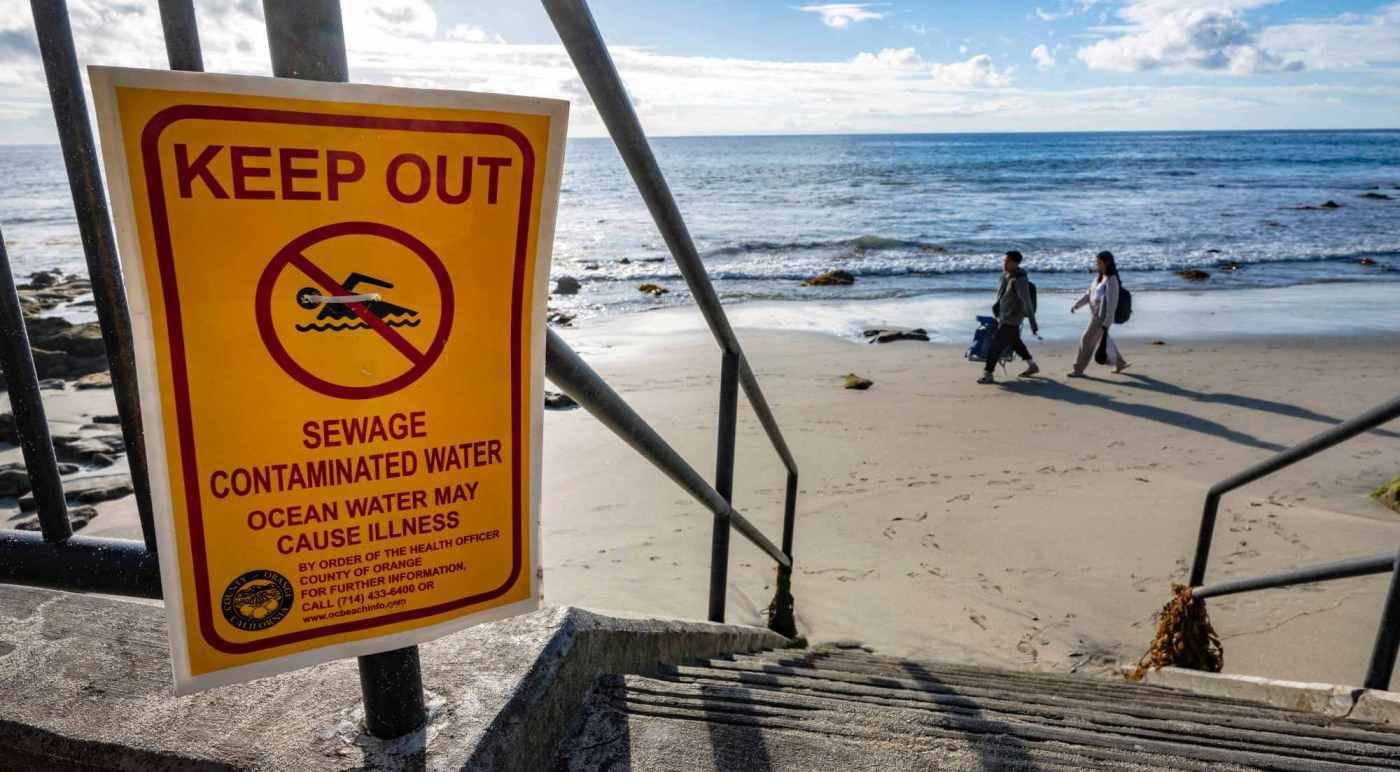There were 71 sewage spills reported to the OC Health Care Agency last year, three that resulted in ocean or harbor closures, far below the annual average.
The county agency recently released its Harbor and Bay Water Quality Report, published every two years, which said beach closures caused by sewage spills remained low for the 13th consecutive year. The report also looked at how beaches fared for bacteria and other coastal-related public health concerns, including tar on the sand and oil sheens in the ocean.
The average for the 38 years the agency has been tracking spills – 1987 through 2024 – is 178 spills per year. The three closures reported in 2024 resulted in a total of 11 days where people were warned away from the water, fewer than the average 16 beach closures resulting in 57 closure days seen since 1999.
There were several sewage spills the previous year, 2023 — the worst happened in late November in Laguna Beach, with 152,705 gallons of sewage that flowed into open coastal areas near Laguna Avenue, the result of a city line break during repairs.
In 2024, 30,000 gallons of sewage flowed to the beach at the San Gabriel River Jetty to the Anaheim Bay breakwater from a Los Angeles County Sanitation spill.

Two spills happened in Dana Point, the first in the harbor near Baby Beach when a line blockage spilled 20 gallons of sewage. The other happened near Salt Creek, caused by a broken pipe at the Moulton Niguel Water District that released nearly 19,000 gallons of sewage.
The report said none of the closures originated from private properties.
Blockages in pipelines have been responsible for an average of 61% of all beach closures since 1999, with the major causes being the infiltration of roots and the buildup of grease.
An estimated 7,500 ocean, harbor and bay water samples were collected last year, with 22,500 analyses performed to determine the levels of three indicator bacteria used for compliance purposes – total coliform, fecal coliform and enterococcus.
The report indicated posted warnings due to violations of bacteriological water quality standards continue to trend down.
Last season, Bolsa Chica Beach, Crystal Cove State Beach and Capistrano County Beach did not produce results exceeding any bacteriological standards. “Excellent” water quality was recorded at Seal Beach/Surfside/Sunset Beach, Huntington Beach city and state beaches, Newport Beach, Dana Point and San Clemente
In 2024, nine rain advisories were issued, resulting in a total of 64 days when people were warned to stay out of the water for health reasons. Rain advisories are issued when bacterial levels are elevated and can cause illness to swimmers, surfers and divers.
Beaches that struggled the most with needing warning posted were Doheny State Beach and Poche County Beach.
Garry Brown, founder and president of Orange County Coastkeeper, called the report’s findings “excellent news” for the county.
Brown recalled a 1998 report that said Orange County’s 42 miles of coast had 1,000 postings or closings of the beach – a figure so shocking it prompted him to start the nonprofit organization.
Coastkeeper works with sanitation and water districts, as well as cities, to help figure out solutions and Brown said many have made major improvements through the decades.
“To their credit, they realized that sewage spills and contaminated beaches were no longer acceptable to the public,” he said, noting Orange County Sanitation has made a big effort in updating its infrastructure. “They are owed credit for doing a better job.”
But, he noted, “we still have a lot of work to do.” Laguna Beach, he said, has an aging system that needs to be addressed.
He also said more needs to be done in general to prevent nutrients and phosphates from entering coastal waters, “as they are the cause of algal blooms that are currently harming sea lions, dolphins, and other sea animals along our coast.”
“Our work continues,” he added, “to prevent contaminants from entering the waste stream and from being discharged into the ocean.”
Some of what mucks up the beaches can come from nature. The report indicated there was an unusual amount of tar balls in spring 2023 observed on beaches throughout Orange County.
“Tar balls are little, dark-colored pieces of oil that can sometimes stick to your feet when you go to the beach,” the report’s authors noted. “They can be from natural occurring seeps, places where oil slowly escapes from the earth surface above petroleum reservoirs or are remnants of oil spills.”
There was also an iron-oxidizing bacteria in February 2024 that created a bright orange runoff in southern Orange County.
“Although the iron-oxidizing bacteria are not a direct health threat risk to humans, they create an unsightly rusty orange substance on the beach,” the report said.
There was also a 2-mile oil sheen spotted in March 2024 off Huntington Beach, with the health care agency issuing precautions to beachgoers.
“It is critical to accurately measure and assess the overall health of our coastal waters through a full range of indicators and provide this information to the public in a biennial report,” health officials said in their report, noting it covers 42 miles of coastline and 70 miles of harbor and bay frontage.
The biennial report does not set goals, make recommendations or offer advice, but provides data for use by government officials, public agencies, environmental groups, concerned citizens and all other interested parties.
